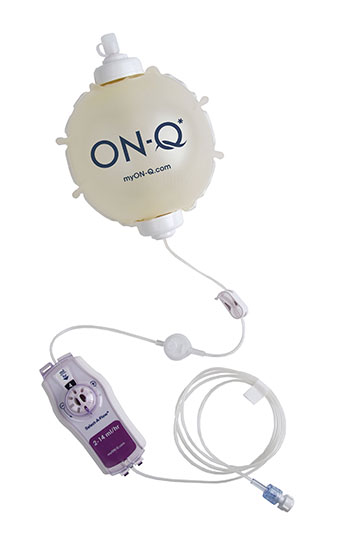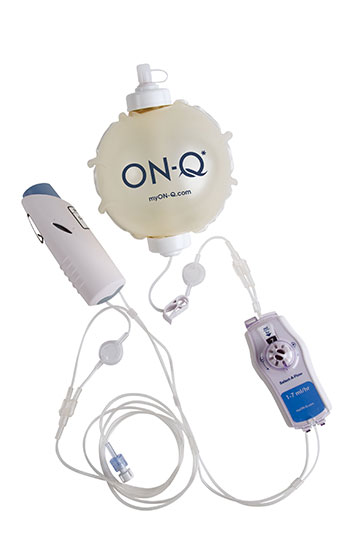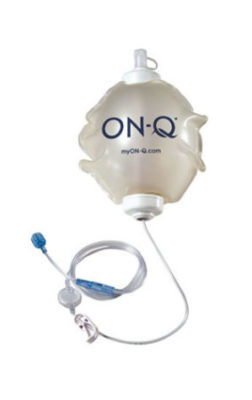EFFECTIVE PAIN RELIEF.1-13
Opioid analgesics and short-duration single-shot nerve blocks may compromise surgical outcomes and patient experiences.3,16-18,20-21 ON-Q* Pain Relief System offers a new total solution for keeping pain management from compromising surgical success. Using a multimodal pain management approach, ON-Q* provides over 3 days of predictable pain relief while reducing opioid use.1-6 Patients can be both comfortable after surgery and capable of activity as they move through recovery.2,6-9,14,22-23 Discover the benefits of ON-Q*:
If you are a patient or caregiver who is interested in learning more about an opioid-sparing solution, view our patient website for more product information, brochures and videos.
ON-Q* Pump with Select-A-Flow* Variable Rate Controller
Flow rate that can be changed according to patients’ individual pain relief requirements
The ON-Q* Pump with Select-A-Flow is a non-narcotic elastomeric pump that automatically and continuously delivers local anesthetic. It provides post-operative pain relief for up to 5 days, while reducing patients’ opioid consumption post-operatively. This pump offers customizable control with titratability and the ability to turn analgesia on and off.
The ON-Q* Pump with Select-A-Flow* Variable Rate Controller offers:
- Provides post-operative pain relief for up to 5 days, while reducing patients’ opioid consumption post-operatively
- Comes with a Select-A-Flow * dial to allow for customizable control of the flow rate, depending on the patient’s pain level
- Available in 400 ml and 600 ml that can be filled to 550 ml and 750 ml, respectively, for longer duration of therapy
- Available in 1-7 m/hr and 2-14 ml/hr
With the ON-Q* Pain Relief System, patients:
- Went home an average of 1.1 days sooner
- Reported up to 69% lower pain scores
- Were up to 3x as likely to report high satisfaction scores
- Are more likely to experience better pain management with fewer side effects


ON-Q* Pump with ONDEMAND* Bolus Button
Bolus device allows for breakthrough pain relief on demand.
The ON-Q* Pump with ONDEMAND* Bolus Button:
- Incorporates a bolus device, which allows for breakthrough pain relief on demand by the patient or healthcare provider.
- The pump also delivers continuous infusion (basal)
- Allows both continuous and ONDEMAND* pain relief
- Unique and ergonomic patient-controlled button
With ON-Q*, patients:
- Went home an average of 1.1 days sooner
- Reported up to 69% lower pain scores
- Were up to 3x as likely to report high satisfaction scores
- Are more likely to experience better pain management with fewer side effects
ON-Q* Pump with Select-A-Flow* Variable Rate Controller and ONDEMAND* Bolus Button
Allows for titratable pain relief and a bolus device for breakthrough pain relief on demand.
The ON-Q* Pump with Select-A-Flow* Variable Rate Controller and ONDEMAND* Bolus Button contains both a variable rate controller that enables the flow rate to be changed according to patients’ individual pain relief requirements and a bolus device that allows for breakthrough pain relief on demand by the patient or healthcare provider.
- Provides pain relief for up to 5 days, while reducing patients’ opioid consumption post-operatively
- Comes with the Select-A-Flow* dial for customizable control for different pain levels
- Incorporates a bolus device which allows patients or healthcare providers to give an additional dose of analgesia
- Unique and ergonomic bolus button
With the ON-Q* Pain Relief System, patients:
- Went home an average of 1.1 days sooner
- Reported up to 69% lower pain scores
- Were up to 3x as likely to report high satisfaction scores
- Are more likely to experience better pain management with fewer side effects


ON-Q* Fixed Flow Rate Pump
Automatically and continuously delivers medication
The ON-Q* Fixed Flow Pump is a non-narcotic elastomeric pump that automatically and continuously delivers a regulated flow of local anesthetic to a patient’s surgical site or in close proximity to nerves, providing targeted pain relief for up to 3-5 days. Designed to provide continuous relief, the ON-Q* Fixed Flow Pump is available with multiple volume capacity and flow rate options.
The ON-Q* Fixed Flow Pump:
- Automatically and continuously delivers medication
- Available in a variety of volumes and flow rates
- Targeted pain relief for up to 3-5 days
With the ON-Q* Pain Relief System, patients:
- Went home an average of 1.1 days sooner
- Reported up to 69% lower pain scores
- Were up to 3x as likely to report high satisfaction scores
- Are more likely to experience better pain management with fewer side effects
Technical Bulletins
- ONDEMAND* Bolus Device Red Tab Removal
- ON-Q* Latex Sensitivity
- Fill Port Sterility Testing
- Latex Bladder Color Variation
- The Joint Commission: Infusion Pumps
- Pump Filling Technique
- ON-Q* Pumps with ONDEMAND*
- Pump Priming, FF rate
- Chondrolysis Today
- ON-Q* & 797 Prior to Use Storage
- Pediatric Use
- In-Situ Catheter Breakage
- Hand and Foot Surgery Continuous Infusion
- ON-Q* Pump Priming, FF Rate
- ON-Q* in the MR Env
- SAF Drug Dose Info
- Storage Times on Flow Rate of Prefilled Pumps
- Stability Data for Pain Management Meds
- Factors ON-Q* Fixed Flow
- Product Storage Requirements
- Effects of LifeTech Prolong Catheter
- DEHP in ON-Q* Products
- Avanos Elastomeric Pump
- Duration of Therapy
- Factors Affecting Flow Rate – ON-Q* Pumps
There are inherent risks in all medical devices, please refer to the product labeling for Indications, Cautions, Warnings and Contraindications. For example, failure to follow the product labeling regarding filling, flow rate selection and placement of the pump and/or catheter could directly impact patient safety. Physician is responsible for prescribing and administering medications per instructions provided by the drug manufacturer. Refer to the website for product safety Technical Bulletins. For specific questions regarding the pump or medication prescribed to you, please contact your physician.
References
- Dine A. Evidence based outcomes review. Continuing review and evaluation for I‐Flow Corporation. July 2012.
- Liu SS, Richman JM, Thirlby RC, Wu CL. Efficacy of continuous wound catheters delivering local anesthetic for postoperative analgesia: a quantitative and qualitative systematic review of randomized controlled trials. J Am Coll Surg. 2006;203(6):914‐932.
- Bingham AE, Fu R, Horn JL, Abrahams MS. Continuous peripheral nerve block compared with single‐injection peripheral nerve block: a systematic review and metaanalysis of randomized controlled trials. Reg Anesth Pain Med. 2012;37(6):583‐594.
- Goyal N, McKenzie J, Sharkey PF, Parvizi J, Hozack WJ, Austin MS. The 2012 Chitranjan Ranawat award: intraarticular analgesia after TKA reduces pain: a randomized, double‐blinded, placebo‐controlled, prospective study. Clin Orthop Relat Res. 2013;471(1):64‐75.
- Gómez‐Cardero P, Rodríguez‐Merchán EC . Postoperative analgesia in TKA: ropivacaine continuous intraarticular infusion. Clin Orthop Relat Res. 2010;468(5):1242‐1247.
- Auyong DB, Allen CJ, Pahang JA, Clabeaux JJ, MacDonald KM, Hanson NA. Reduced length of hospitalization in primary total knee arthroplasty patients using an updated enhanced recovery after orthopedic surgery (ERAS) pathway. J Arthroplasty. 2015;30(10):1705‐1709.
- Beaussier M, El’Ayoubi H, Schiffer E, et al. Continuous preperitoneal infusion of ropivacaine provides effective analgesia and accelerates recovery after colorectal surgery. Anesthesiology. 2007;107(3):461‐468.
- Bianconi M, Ferraro L, Traina GC, et al. Pharmacokinetics and efficacy ofropivacaine continuous wound instillation after joint replacement surgery. Br J Anaesth. 2003;91(6):830‐835.
- White PF, Rawal S, Latham P, Markowitz S, et al. Use of a continuous local anesthetic infusion for pain management after median sternotomy. Anesthesiology. 2003;99(4):918‐923.
- Mudumbai SC, Kim TE, Howard SK, et al. Continuous adductor canal blocks are superior to continuous femoral nerve blocks in promoting early ambulation after TKA. Clin Orthop Relat Res. 2014;472(5):1377‐1383.
- Capdevila X, Barthelet Y, Biboulet P, Ryckwart Y, Rubenovitch J, d’Athis F. Effects of perioperative analgesic technique on thesurgical outcome and duration of rehabilitation after major knee surgery. Anesthesiology. 1999;91(1):8‐15.
- Ilfeld BM, Ball ST, Gearen PF, et al. Ambulatory continuous posterior lumbar plexus nerve blocks after hip arthroplasty: a dualcenter, randomized, triple‐masked, placebo‐controlled trial. Anesthesiology. 2008;109(3):491‐501.
- Carli F, Clemente A, Asenjo JF, et al. Analgesia and functional outcome after total knee arthroplasty: periarticular infiltration vs continuous femoral nerve block. Br J Anaesth. 2010;105(2):185‐195.
- Forastiere E, Sofra M, Giannarelli D, Fabrizi L, Simone G. Effectiveness of continuous wound infusion of 0.5% ropivacaine by ON‐Q pain relief system for postoperative pain management after open nephrectomy. Br J Anaesth. 2008;101(6):841‐847.
- Chelly JE, Ghisi D, Fanelli A. Continuous peripheral nerve blocks in acute pain management. Br J Anaesth. 2010;105(suppl 1):86‐96.
- Aguirre J, Del Moral A, Cobo I, Borgeat A, Blumenthal S. The role of continuous peripheral nerve blocks. Anesthesiol Res Pract. 2012;2012:1‐20.
- Heller L, Kowalski AM, Wei C, Butler CE. Prospective, randomized, double‐blind trial of local anesthetic infusion and intravenous narcotic patient‐controlled anesthesia pump for pain management after free TRAM flap breast reconstruction. Plast Reconstr Surg. 2008;122(4):1010‐1018.
- Kean J, Wigderowitz CA, Coventry DM. Continuous interscalene infusion and single injection using levobupivacaine for analgesia after surgery of the shoulder: a double‐blind, randomized controlled trial. J Bone Joint Surg [Br]. 2006;88‐B:1173‐ 1177.
- Husain A, Lee GC. Establishing realistic patient expectations following total knee arthroplasty. J Am Acad Orthop Surg. 2015;23(12):707‐713.
- Benyamin R, Trescot AM, Datta S, et al. Opioid complications and side effects. Pain Physician. 2008;11:s105‐s120.
- Abdallah FW, Halpern SH, Aoyama K, Brull R. Will the real benefits of single‐shot interscalene block please stand up? Asystematic review and meta‐analysis. Anesth analg. 2015;120(5):1114‐1129.
- Webb C, Mariano E. Best multimodal analgesic protocol for total knee arthroplasty. Pain Management. 2015;5(3):185‐196.
- Perlas A, Kirkham K, Billing R et al. The impact of analgesic modality on early ambulation following total knee arthroplasty. Reg Anesth Pain Med. 2013;38(4):334‐339.
